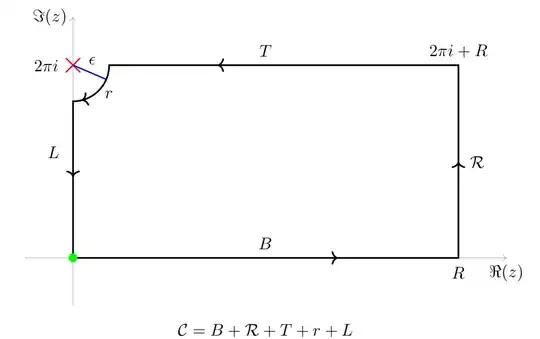I present my two proofs here, the second one is the simpler proof but relies heavily on the Weierestrass factorization. The first proof is slightly more involved but more rigorous:
Proof 1):
We know that:
$\arctan(x)=x-\dfrac{x^3}{3}+\dfrac{x^5}{5}-\dfrac{x^7}{7}+\cdots$
Now,$$\int x^1\arctan(x) \,dx=\dfrac{x^3}{1\cdot3}-\dfrac{x^5}{3\cdot5}+\dfrac{x^7}{5\cdot7}+\cdots--(1)$$
$$\int x^3\arctan(x) \,dx=\dfrac{x^5}{1\cdot5}-\dfrac{x^7}{3\cdot7}+\dfrac{x^9}{5\cdot9}+\cdots--(2)$$
$$\int x^5\arctan(x) \,dx=\dfrac{x^7}{1\cdot7}-\dfrac{x^9}{3\cdot9}+\dfrac{x^11}{5\cdot11}+\cdots--(3)\cdots$$
Notice that if one were to add all these equations and replace $x$ with $i$, they would get the residual value from the square of the Leibniz pi formula times $i$.... I.E:
$$\dfrac{\pi}{4}\cdot\dfrac{\pi}{4}=\left(1-\dfrac{1}{3}+\dfrac{1}{5}-\dfrac{1}{7}+\dfrac{1}{9}+\cdots \right)\left(1-\dfrac{1}{3}+\dfrac{1}{5}-\dfrac{1}{7}+\dfrac{1}{9}+\cdots \right)$$
$$\dfrac{\pi^2}{16}=\dfrac{1}{1^2}+\dfrac{1}{3^2}+\dfrac{1}{5^2}+\dfrac{1}{7^2}+\cdots+2\left(-\dfrac{1}{1\cdot3}+\dfrac{1}{1\cdot5}-\dfrac{1}{1\cdot7}+\cdots-\dfrac{1}{3\cdot5}+\dfrac{1}{3\cdot7}+\cdots \right)$$
$$\dfrac{\pi^2}{16}=\left(\dfrac{1}{1^2}+\dfrac{1}{3^2}+\dfrac{1}{5^2}+\dfrac{1}{7^2}+\cdots \right)+2K(Say)--(@)$$
Now $$K=\sum_{n=0}^{\infty}\int I^{2n+1} dx=\sum_{n=0}^{\infty} \int x^{2n+1}\arctan(x) dx$$, Where $I^{1}=(1); I^{3}=(2); I^{5}=(3)\cdots$
$$I^{1}=\int x^1\arctan(x) \,dx=\dfrac{(x^2+1)\arctan(x)-x}{2}$$
$$I^{3}=\int x^3\arctan(x) \,dx=\dfrac{(3x^4-3)\arctan(x)-x^3+3x}{12}$$
$$I^{5}=\int x^5\arctan(x) \,dx=\dfrac{(15x^6+15)\arctan(x)-3x^5+5x^3-15x}{90}$$
On replacing $x=i$ in all these equations, we get: $I^{1}=-\dfrac{i}{2}; I^{3}=\dfrac{i}{3}; I^{5}=-\dfrac{23i}{90}; I^{7}=\dfrac{22i}{105}\cdots$
Upon adding these values we get:
$$K=-\dfrac{i}{2}+\dfrac{i}{3}-\dfrac{23i}{90}+\dfrac{22i}{105}-\cdots--(*)$$
Now, we know the Taylor series expansion for $\arctan^2(x)=x^2 - \dfrac{2}{3}x^4 + \dfrac{23}{45}x^6 - \dfrac{44}{105}x^8 + \dfrac{563}{1575}x^{10} + \cdots$
By observation, we can see that (*) is equal to the negative half of the $\arctan^2(x)$ expansion at $x=1$
Therefore, $$\dfrac{\arctan^2(1)}{2}=-(*)=-K=\dfrac{\pi^2}{32}=(-1)\cdot\left(-\dfrac{1}{1\cdot3}+\dfrac{1}{1\cdot5}-\dfrac{1}{1\cdot7}+\cdots-\dfrac{1}{3\cdot5}+\dfrac{1}{3\cdot7}+\cdots \right)$$
This result can be substituted in $(@)$, to get:
$$\dfrac{\pi^2}{16}=\dfrac{1}{1^2}+\dfrac{1}{3^2}+\dfrac{1}{5^2}+\dfrac{1}{7^2}+\cdots+2K=\dfrac{1}{1^2}+\dfrac{1}{3^2}+\dfrac{1}{5^2}+\dfrac{1}{7^2}+\cdots-\dfrac{\pi^2}{16}$$
Which results in,$$\dfrac{\pi^2}{8}=\dfrac{1}{1^2}+\dfrac{1}{3^2}+\dfrac{1}{5^2}+\dfrac{1}{7^2}+\dfrac{1}{9^2}+\dfrac{1}{11^2}+\dfrac{1}{13^2}+\dfrac{1}{15^2}+\cdots--(!)$$
Now consider:$$L=\dfrac{1}{1^2}+\dfrac{1}{2^2}+\dfrac{1}{3^2}+\dfrac{1}{4^2}+\dfrac{1}{5^2}+\dfrac{1}{6^2}+\cdots=(!)+(L/4)$$
$$=>\dfrac{3L}{4}=(!)=\dfrac{\pi^2}{8}$$
Therefore,$$L=\dfrac{\pi^2}{6}=\dfrac{1}{1^2}+\dfrac{1}{2^2}+\dfrac{1}{3^2}+\dfrac{1}{4^2}+\dfrac{1}{5^2}+\dfrac{1}{6^2}+\cdots$$
Proof 2):
This is by no means rigorous but I found it was enough to give me a general intuition to approach problems like these.
Consider a polynomial:$a_nx^n+a_{n-1}x^{n-1}+\cdots+a_2x^2+a_1x+a_0$
Now the summation of the reciprocal products (Two at a time):
$$\sum{\dfrac{1}{r_i\cdot r_j}}=\dfrac{a_2}{a_0}$$
Consider $\cos(x)$ as the "polynomial" function. The Taylor expansion is:
$1-\dfrac{x^2}{2!}+\dfrac{x^4}{4!}-\cdots$
The roots of $\cos(x)$ are:
$\dfrac{\pi}{2},\dfrac{-\pi}{2},\dfrac{3\pi}{2},\dfrac{-3\pi}{2},\dfrac{5\pi}{2},\cdots$
Here, $\sum{\dfrac{1}{r_i\cdot r_j}}=\dfrac{a_2}{a_0}=\dfrac{-1}{2}$
So,$$\dfrac{-1}{2}=\dfrac{1}{\dfrac{\pi}{2}}(\dfrac{1}{\dfrac{3\pi}{2}}+\dfrac{1}{\dfrac{5\pi}{2}}+\cdots+\dfrac{1}{\dfrac{-\pi}{2}}+\dfrac{1}{\dfrac{-3\pi}{2}}+\cdots)+\dfrac{1}{\dfrac{3\pi}{2}}(\dfrac{1}{\dfrac{\pi}{2}}+\dfrac{1}{\dfrac{5\pi}{2}}+\cdots+\dfrac{1}{\dfrac{-\pi}{2}}+\dfrac{1}{\dfrac{-3\pi}{2}}+\cdots)+\dfrac{1}{\dfrac{5\pi}{2}}(\dfrac{1}{\dfrac{\pi}{2}}+\dfrac{1}{\dfrac{3\pi}{2}}+\dfrac{1}{\dfrac{7\pi}{2}}+\cdots+\dfrac{1}{\dfrac{-\pi}{2}}+\dfrac{1}{\dfrac{-3\pi}{2}}+\dfrac{1}{\dfrac{-5\pi}{2}}\cdots)+\cdots$$
This results in:
$$\dfrac{1}{\dfrac{\pi^2}{2}}(\dfrac{1}{\dfrac{3}{2}}+\dfrac{1}{\dfrac{5}{2}}+\cdots+\dfrac{1}{\dfrac{-1}{2}}+\dfrac{1}{\dfrac{-3}{2}}+\cdots)+\dfrac{1}{\dfrac{3\pi^2}{2}}(\dfrac{1}{\dfrac{1}{2}}+\dfrac{1}{\dfrac{5}{2}}+\cdots+\dfrac{1}{\dfrac{-1}{2}}+\dfrac{1}{\dfrac{-3}{2}}+\cdots)+\cdots$$
Resulting in:
$$-\dfrac{1}{2}=\dfrac{1}{\dfrac{\pi^2}{2}}\dfrac{1}{(\dfrac{-1}{2})}+\dfrac{1}{\dfrac{3\pi^2}{2}}\dfrac{1}{(\dfrac{-3}{2})}+\dfrac{1}{\dfrac{5\pi^2}{2}}\dfrac{1}{(\dfrac{-5}{2})}+\cdots$$
Therefore, $$\dfrac{\pi^2}{8}=\dfrac{1}{1^2}+\dfrac{1}{3^2}+\dfrac{1}{5^2}+\dfrac{1}{7^2}+\cdots$$
Consequently, $$\dfrac{\pi^2}{6}=\dfrac{1}{1^2}+\dfrac{1}{2^2}+\dfrac{1}{3^2}+\dfrac{1}{4^2}+\cdots$$


eulertag. – J. M. ain't a mathematician Oct 30 '10 at 10:22